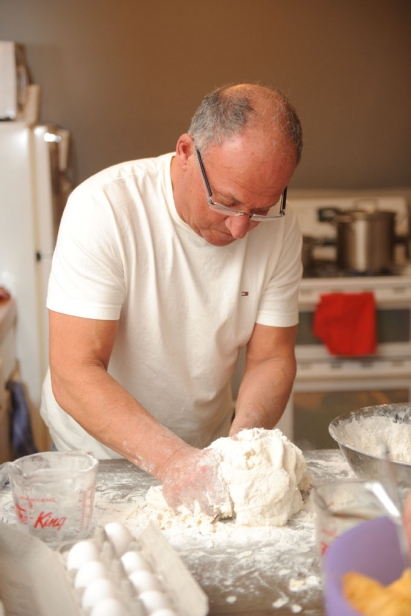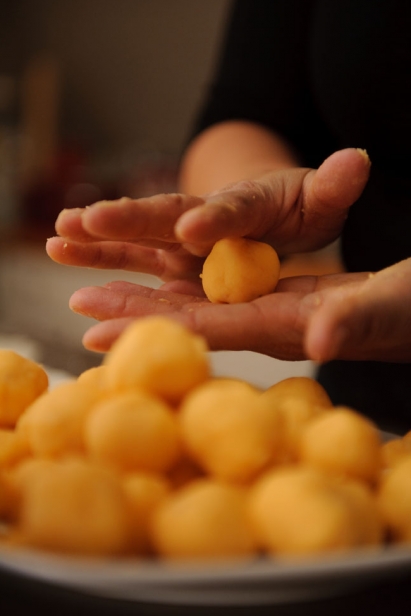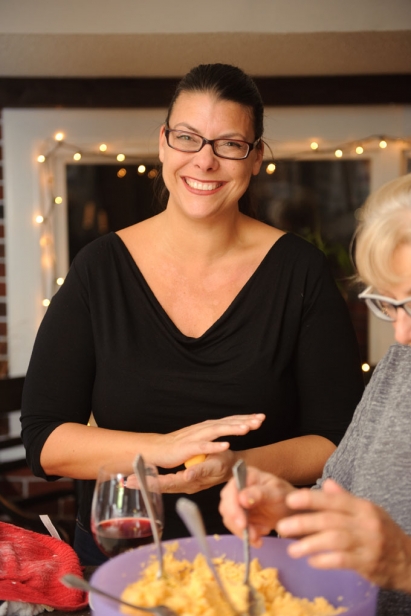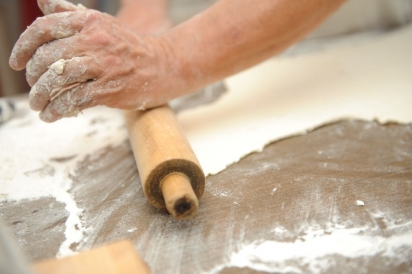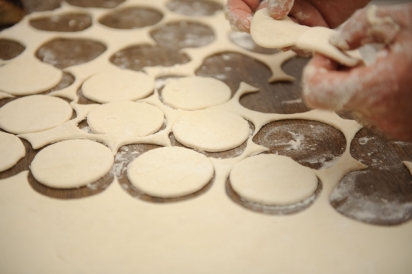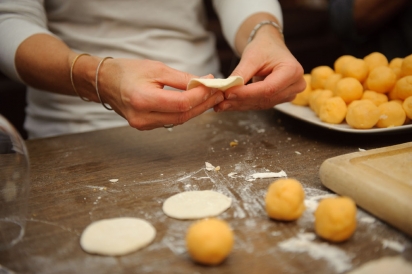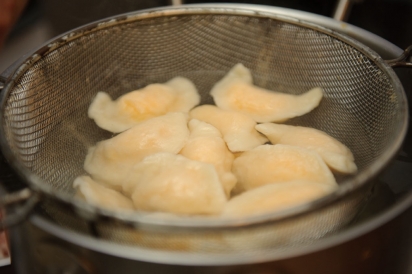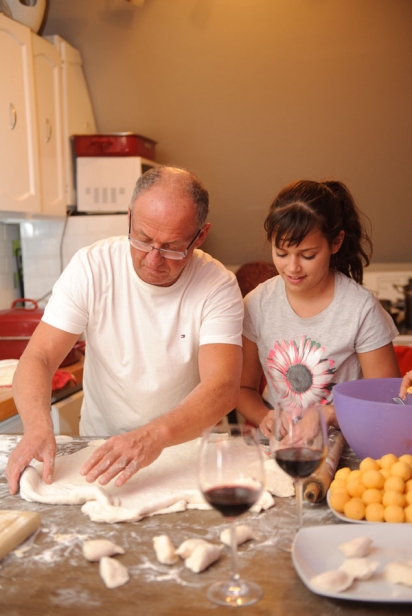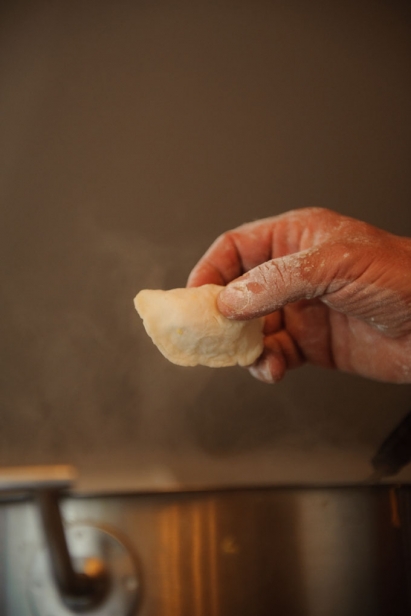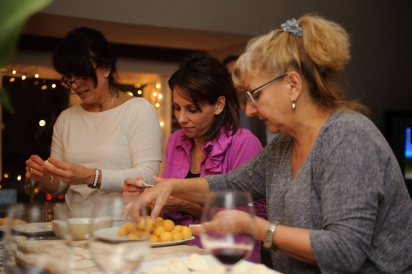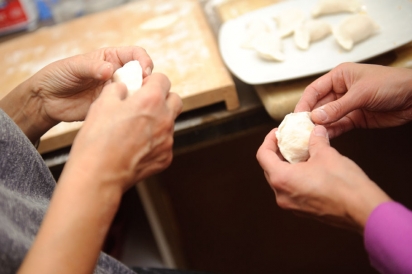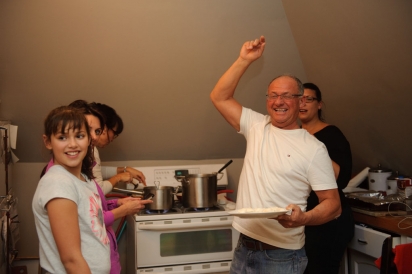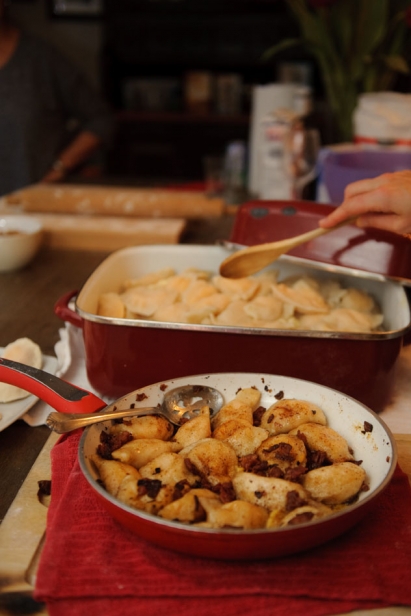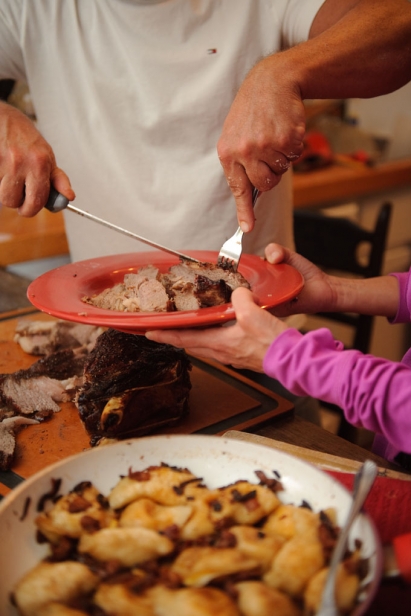Pinched to Perfection
If you’re lucky enough to join Vanessa Simmons and her family for a “pinch-o-rama,” you can expect the music and conversation to be lively, the wine to be plentiful and the homemade perogies to be nothing short of perfection.
“They look like little pillows — they’re just beautiful,” says Simmons of the mouth-watering perogies they prepare in huge batches three times a year. “Ever since we were kids, I don’t remember a major event without our perogy tradition.
“These are the traditions of our Ukrainian heritage — my mother’s mother’s side of our family,” explains Simmons. “All of my grandmother’s brothers and sisters and brothers- and sistersin- law used to get together to make them. It was always just a big, family pinch-o-rama.”
In a nod to this tasty custom, Simmons and her extended family gather before every Thanksgiving, Christmas and Easter to make perogies. Typically, they meet on a Thursday evening — in anticipation of the big, family dinner planned for the following Saturday. It’s a highly efficient assembly-line production that yields a staggering number of perogies — typically between 350 and 500 — in about two hours.
There’s also very good news for those hungry outsiders looking in — newcomers are always welcomed with open arms.
“Sometimes people just don’t have family in town on a special occasion, or they don’t have the benefit of seeing family every day,” says Simmons. “We have a lot of very good friends who have family out of town, so they participate, and my family is their family. “We’ve always been very inclusive that way, and very open and very welcoming of having other people there.”
Let’s get rolling
The festivities often take place in the humble, apartment-sized kitchen of Simmon’s fun-loving uncle, Bob Posch.
“Usually we meet at Bobby’s place because he’s the instigator and he always does the dough,” says Simmons, adding that Posch downsized from a larger home to his current Westboro apartment, located above his design and construction business on Churchill Avenue. “He went from having a countertop that was five times the size so we could spread out, to having a tiny little place now — we always make it happen anyway.
“It’s really less about the locale and more about the tradition of just bringing family together. It doesn’t matter who spearheads, what your house looks like, whether you’re under construction or not; we’ve had to ad lib some of these things along the way.”
When his mother, Katie Posch, passed away in 1982, Bob took over the tradition of preparing the dough. He also looks after making the potato filling, which is done a day before the pinching party.
“Potatoes are always made the night before, with a 10-pound bag of potatoes, five pounds of St. Albert extra old orange cheese and pepper,” says Simmons. “Those are the only things that go in — just those three ingredients.”
Simmons explains that once the potatoes are cooked, they must be mashed with the cheese and pepper to just the right consistency. “You don’t want it too gummy and too paste-y inside — you still want to taste some potato consistency, but you don’t want it too lumpy.”
They then refrigerate the potato mixture overnight. “Then it's a nice, hard consistency — so they’re not mushy. Think of a fresh, out-of-the fridge cookie dough — that’s the consistency we want.”
When everyone converges the following day, Posch prepares the dough. It’s a simple mixture of flour, eggs, oil and water.
“He’s really the only guy who still has the hang of doing the dough, everybody else has fallen into a role to play,” says Simmons. “At times, dough is flying — because Uncle Bobby thinks it’s funny to throw dough at people.”
Posch never re-uses the dough once he's cut it — because it’s not the same, it doesn’t have the same elasticity. Simmons adds that the rolling pin used for the dough is a family heirloom.
“We call it ‘Baba’s rolling pin,’ she says. “So this was my great aunt’s mother’s rolling pin that I have, that we use for rolling out the dough, as part of the tradition.”
When the dough is ready to go, Simmons takes charge of the next steps — rolling and cutting. “I can get it to the right consistency and thickness.”
It’s very important to ensure the dough is cut into circles that are just the right size. Simmons says there’s a special glass that comes out every time — a tumbler-sized glass or a wine glass, which is a particular size that works best.
"Then we have the ball rollers,” she says, adding that her brother, Johnny, often takes on this role with several others."
“We have to make sure the ball is a nice size to go in, so that when you’re pinching it and folding it over you just have enough of a stretch that you’ll be able to pinch and close it — but not too much that it’s stretched too thin — because you still want that even dough all the way across your perogy on the outside.”
Ready, set, pinch
The most important part of the perogy process is the pinching, says Simmons. It’s a position of great honour — but you’ve got to have a sharp eye for detail and a dedication to a quality result.
“You really have to get that nice, scalloped, pinched edge on the outside,” says Simmons. “You need people with good, nimble fingers; we’ve actually fired people from perogy pinching — if you can’t pinch them closed properly.”
Until last Easter, the role of head pincher was held by Simmons’ younger sister, Kim Salvati, who passed away earlier this year.
“Kim had that focus and that discipline and creativity and ability for the tiny, small, minutia details that really make a difference,” says Simmons, adding that her sister was a very creative, crafty person. “I think all of that — together with her love of family tradition — helped her get the title of ‘Queen Perogy Pincher.’
“She always had that big role. It was bragging rights, and a claim that she got every time.”
Kim’s eldest daughter, 10-year-old Sapphira, is already helping to carry on the tradition of making perogies with the family. In addition, 12-year-old Hanna — who is Simmon’s cousin Joanne’s daughter — has helped to pinch perogies a couple of times.
“She just loved it,” says Simmons. “I’m giving both of the girls cooking stuff as they get older, so they can start building their own traditions and start participating in family activities — especially in the kitchen.”
Time for tasting
Once the hard work is done and the perogies have been boiled, it’s time for the best part — quality control.
“We always have some type of big meal, because you have to test them — to make sure they’re on par for the big celebration,” says Simmons. “We always have enough perogies that come out of the pot for testing — either floated in the jus of a prime rib, or we’ll do a couple fried on the stove or some right out of the pot nicely coated in butter, and then they just bake for a little while after they’ve been boiled.”
Most of the cooked perogies are put into a big roasting pan — with about three pounds of butter.
“It’s very important when you’re putting the new boiled ones in to make sure that you catch the steam off the side of the roasting pot so that no excess water gets in,” Simmons emphasizes. “If you get water in from the steam and you open and close the roasting lid all the time, they get mushy."
The perogies are never served with onions or sour cream; Simmons says they’re a family of purists. “We just do purist cheese, potatoes and pepper — that’s it,” she says. “You don’t need anything else when you have the fabulous, homemade perogies as they are.”
On the day of the formal serve — be it Thanksgiving, Christmas or Easter — the perogies are put back into the oven till they are warmed through. “They just sit in the butter and we warm them; it’s less of a baking and more of a keeping them warm,” says Simmons. “The bottom ones get a little crispy which is excellent — a buttery crunch.”
The big celebrations usually include between 30 and 45 people. Simmons is forever grateful that the traditions of her ancestors still bring the family together. “Even as older, adult children we all still show up,” she says. “You can’t get away from that tradition and the feeling of family and memories — it’s something you just get drawn to.”
It seems that if Simmons could bottle the flavour of those homemade perogies — mixed with the love and fullness that only comes from a close family – she would most certainly share it with the world.
“I want everybody to come and experience it,” she enthuses. “Every time I have a chance I try to cycle somebody new in — I just want to share it.
“I’m blessed to have such an awesome family that I just want to share that with everybody else. I want them to experience what I experience; I’m very, very lucky.”



